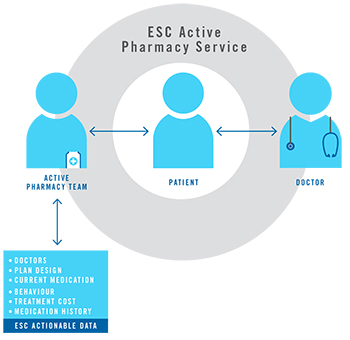As Bette Davis once said, “Old age is no place for sissies.” This is also true of living with chronic disease at any age – poor health compounds all of life’s challenges.
We also know that the majority of people suffer from multiple chronic conditions. In fact, the Express Scripts Canada 2015 Drug Trend Report shows that more than half of plan members with a drug claim suffer from multiple chronic conditions. One in five have four or more chronic diseases at the same time.

Some example cases our data uncovered are:
- A member being treated for breast cancer also requires treatments to help her manage pain, sleep and depression.
- An individual with inadequately controlled type 2 diabetes develops kidney failure and also has dangerously high cholesterol and blood pressure.
- A member diagnosed with multiple sclerosis eventually requires treatment for cognitive impairment, fatigue, depression, gait, nerve pain, muscle spasms, as well as for progressive MS.
Not surprisingly, trying to keep up with treatment for these complex conditions along with the usual demands of life proves too much for many of these individuals. As a result, their health worsens over time.
While the impact on their quality of life cannot be measured, private plan spending provides some insight into the financial burdens. Plan spending for members with chronic complex conditions averaged $2,296 in 2015, 4.7 times that of other members [pg19]. Out-of-pocket costs put enormous pressure on family budgets, and plan costs put the sustainability of employer-sponsored benefits at risk.
Read: Exorbitantly priced drugs challenge Canadian families, benefit plans
Our research shows that an alarming proportion of this drug spending is wasted. This is both a challenge and an opportunity: While it is distressing to think of the money currently being wasted without improving health outcomes, our research also proves that effective support – holistic care models that optimize treatment – can reduce plan costs by an average of $436 per person each year.
The holistic care model savings and other benefits can be much greater for some individuals. For example, when we reviewed the claims history of one of our members with multiple sclerosis [pg24], we found a possible duplication of pain medication that could cause weakness, drowsiness and confusion. By engaging the patient and her doctors to discuss her full medication profile, the possibility of side effects and complications was reduced.
With multiple treatments to keep up with, she was not taking some of her medications as directed by her doctor, partly because of the inconvenience and difficulty of picking up her various prescriptions from four different pharmacies.
Further analysis showed that she could save $5,000 each year by optimizing her pharmacy choices and her drug choices[pg25], in part by making more economical (and convenient) pharmacy choices to pay lower mark-ups on her medication.

Proactive support and coaching from our pharmacy team can help her stay on track with her treatments, avoid complications and side effects, and lower her out-of-pocket and plan costs significantly.
These benefits can be exponential. By putting proactive, supportive treatment plans in place, financial stress is reduced, freeing up time, money and energy to focus on maximizing health through nutrition and physical activity.
It is possible to make treatment more effective and affordable for Canadians with complex, chronic illness – but they can’t do it alone. We can help. Contact us for more information.
